THE DIAMOND TABLE
LEARN ALL ABOUT THE TABLE FACET OF A DIAMOND
This post contains affiliate links. If you use these links to buy something I may earn a commission. Thanks! As an Amazon Associate I also earn from qualifying purchases.
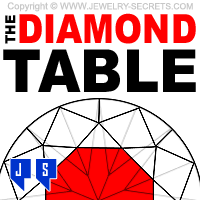
The Table Facet is the top flat portion of the Diamond.
And that’s pretty much it…
Right?
NO WAY!
The Diamond Table is much, much more than that. :)
The Table helps the Diamond Sparkle, it provides a window into the stone, and it can show you instantly if the Diamond is Cut well.
Intrigued?
You should be!
This is Diamond Table 101
Enjoy!
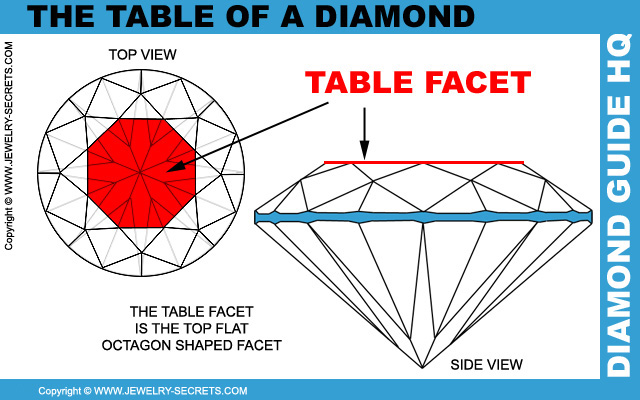
The Round Diamond Table
Fist up, the Table that we will be talking about, is for a Round Brilliant Cut Diamond (Other Fancy Cuts of Diamond, like the Princess Cut, Marquise Cut, Pear Cut, have different shaped Tables and Percentages).
The Table is the top Facet, which is Octagon Shaped (also the same shape as the Culet). The Table Percentage is obtained by measuring the width of the Table, against the width of the Girdle. The Girdle is always the widest part of a Diamond. Every Facet and Percentage is compared to it in size and length.
The width of the Table is compared to the width of the stone as such…
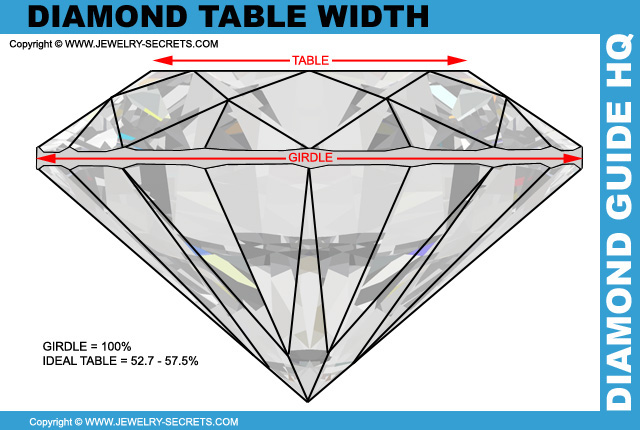
Ideal Table Percentages
Measuring these two (Table and Girdle) will give you the width or Percentage of the Table Facet. An Ideal Percentage Range to stay within is usually 52.4% – 57.5%. Ideal Proportions were created by Marcel Tolkowsky in 1919. Tolkowsky also gave the Depth (Just as important) a Percentage of 58.7% – 62.3% . This is why many Jewelers, and even myself, go by the general rule of 60/60.
The 60/60 Rule
If the Diamond Table is close to 60%, and the Diamond Depth is also close to 60%, then you’d more than likely end up with a pretty decent Cut and a pretty decent looking Diamond.
But, the 60/60 rule was not always the case. You also had to look at the rest of the stone as well. A Diamond Cut 60/60 could be way off as in the image below…
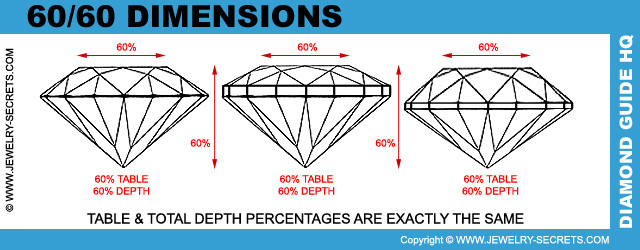
GIA Cut Grades
Since the Cuts of the actual stone could be way off, GIA revised the way they graded Diamonds. They came out with the following Cut Grades: Excellent, Very Good, Good, Fair and Poor. They did this because a Diamond could still be beyond a normal Ideal Range and still look just as beautiful and still have as much sparkle as an Ideal Cut Stone.
The visual aspect now played a huge role in Diamond Grading. It’s not all about Numbers and Percentages anymore.
So a GIA Excellent Cut Grade (The Best there is), for a Brilliant Cut Table could be between 52% – 62%. And a Very Good Cut Grade Table Percentage could be between 50% – 66%.
Take a look at the examples below…
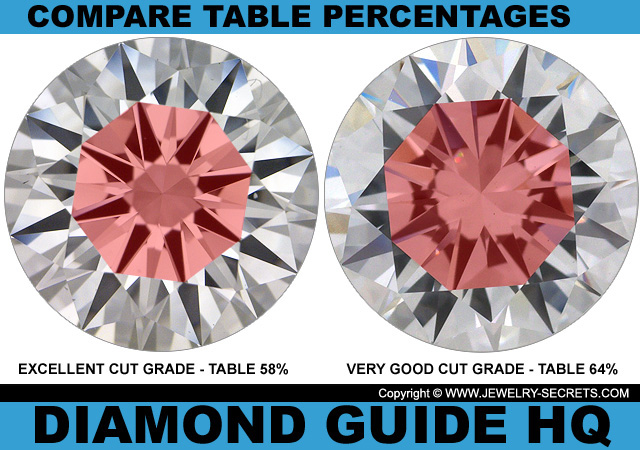
GIA’s Cut Grades simplified Cut and made it easier for Jewelers and Customers to decide if a Diamond was Cut better or worse. People no longer had to look at just Table and Depth and make an educated decision.
It was now easy to determine if your Diamond had a Fish-Eye, or a Nail-Head...
Fish-Eye Diamonds
When the Depth of the stone is too Narrow, Thin or Shallow (beyond 51%), a dark ring would appear around the Pavilion (as viewed through the Table). This ring is called a Fish Eye. It’s actually the reflection of the Girdle in the spread stone. Take a look…
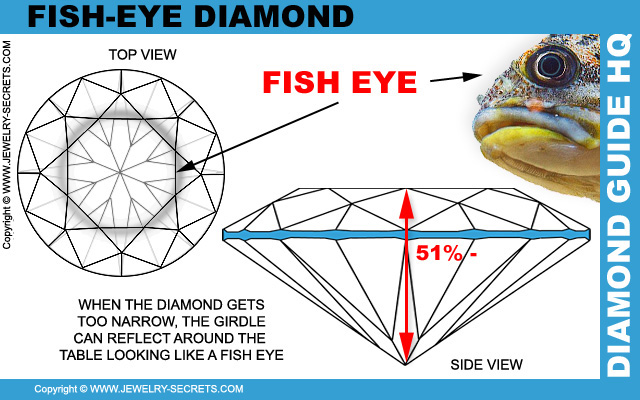
Nail Head Diamonds
When the Diamond Depth was too deep (beyond 70.9%), the light would fall out the bottom of the stone and make the Pavilion appear dark in the center, like a Nail-Head…
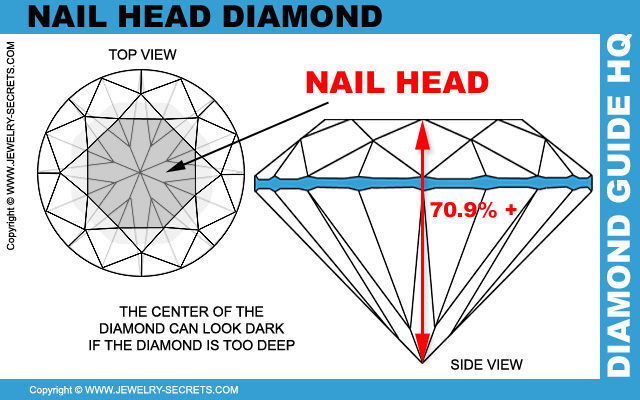
You can look at a Diamond from a Top Down View (looking through the Table), and be able to see if a Diamond is dark in the center.
And, while you’re looking… Look at the reflection of the Table as well. This reflection is seen in the Pavilion and it can alert you to the Make of the stone.
Table Reflection
When you look down into a Diamond, you’ll see the Table reflection, which will usually fall somewhere between the Culet (very center of the Diamond), to the Table edge. As so…
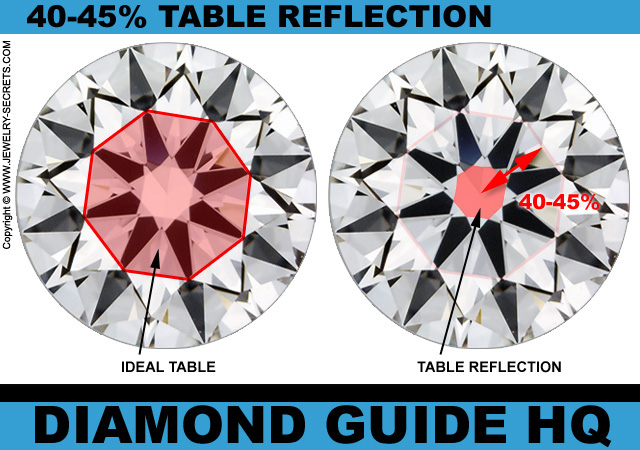
This reflection (highlighted as red on the image) should be between 40%-45% of the way from the Culet to the very edge of the Table. That way, you’ll know if the Diamond is proportioned well and maximizing Sparkle and Shine!
Not only does the Table Size help balance and finish off the stone, but it also helps the Diamond come to life.
If the Cut is really off, the Table Reflection can be a mess. Take a look at the examples of Excellent Cut, Very Good Cut and Good Cut Symmetry Grades below…
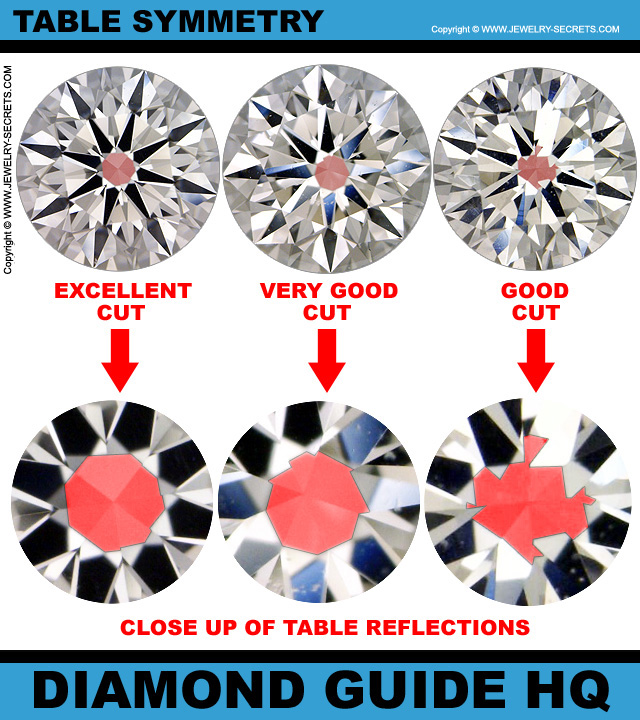
Table Brilliance and Fire
If a Diamond is Cut well, you will get a pretty even amount of both Brilliance (White Flashes of Light), and Fire (Colored Flashes of Light).
White Flashes are caused by light coming in through the table, bouncing around, and coming back out.
Colored Flashes are caused by light entering the Crown Facets, and because it comes in an an angle, the White Light is split into all the colors of a rainbow. As seen here…
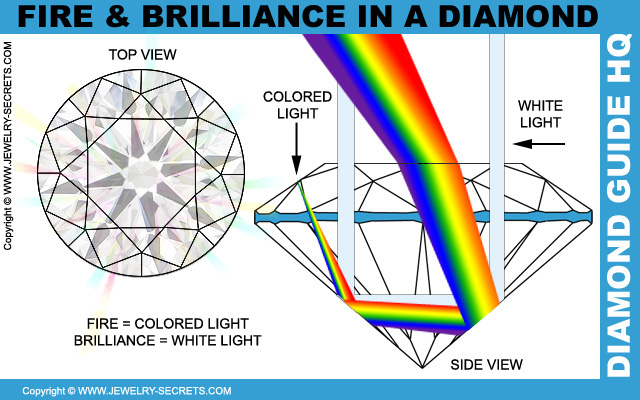
So if a Diamond has a larger Table, you’ll have more light entering into the Table, and the result will be more flashes of White Light than Color in the stone.
Likewise, if the Diamond Table is smaller, you’ll get more Colored Flashes of Light in the Diamond.
What’s cool, is the fact that you can see this happening…
If you look at a Diamond from the side view, you’ll see a line that goes across the Pavilion. This is caused by light entering the Table and Crown Facets, coming down, bouncing across the Pavilion to the other side, before it comes back out in a magnitude of White Light and Colored Light.
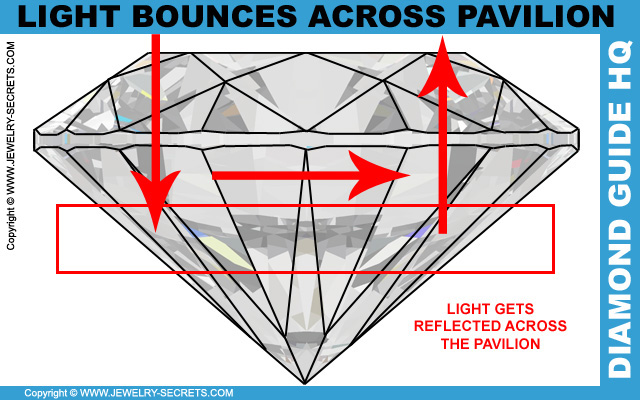
Proportions of the Table
If you tilt the Diamond in the light, so it reflects off the Table, you can see if the shape of the Table is proportioned correctly. The Table should be symmetrical on all sides of the Octagon.
Often you’ll see in Lower Cut Grades, Tables that are uneven, out of proportion, non-symmetrical or bowed out, as so…
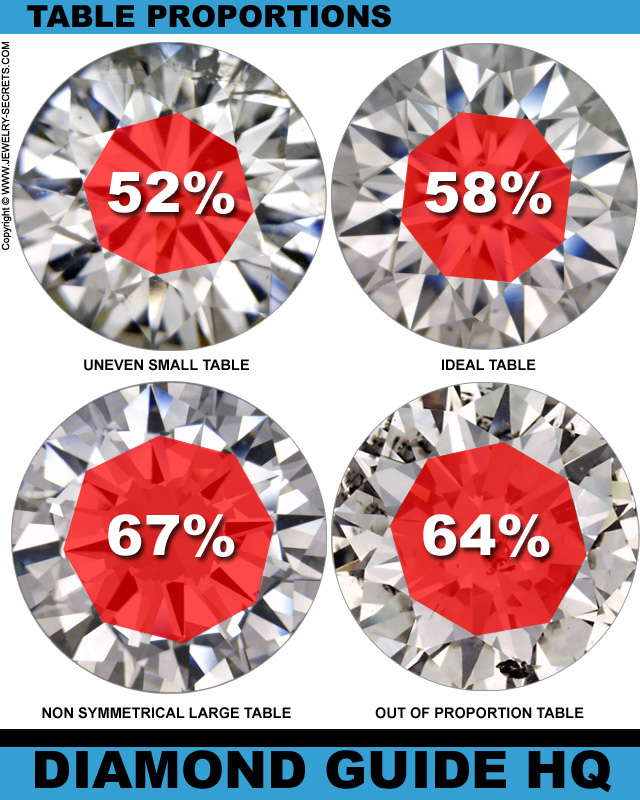
Table Size Affects Appearance
Not only does the Table affect the Cut, Brilliance and Sparkle of the stone, but it also affects how the overall stone looks.
A Table that is very small will actually make the entire Diamond look smaller as well. It’s like an illusion. The Diamond will look like a smaller Carat Weight.
A smaller Table (which I don’t like), tends to make a Diamond look lumpy, like Old Mine-Cut Diamonds, or Old European Cut Stones.
A Table with a slightly larger Table, will make the Diamond appear slightly bigger.
It’s a visual thing that can make or break how a Diamond looks and feels. :)
The Finish of the Table
Something else that you may notice when viewing the reflection coming off the Table… If it’s perfection flat, smooth or not.
The Table should have a perfectly smooth polish to it. But sometimes you will see that the Table looks wavy, has Grain Lines, Polish Marks, Knots, Pits or even Chips in the surface of the stone. Like so…
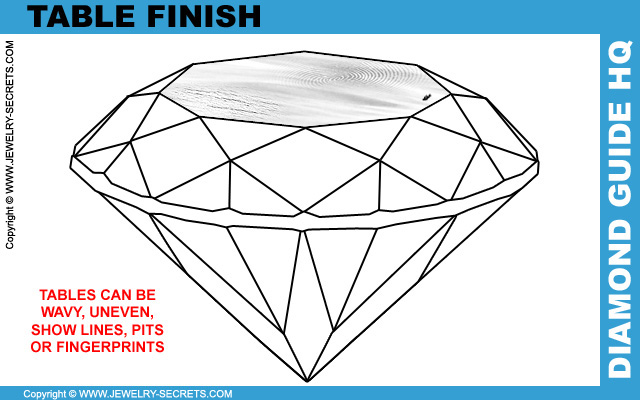
P.S. You can also see a fingerprint on the Table above as well! :)
Things like this happen easily in nature. Diamonds are created in the earth under intense heat and pressure. They’re no where near perfection. It’s like a tree that grows in the forest. It will have tree rings, lines, knots and a rough surface. Signs of creation!
The way a Diamond was Cut could go against the growth lines of the Diamond causing the Table Surface to appear wavy or contain lines or marks.
Look at the Table Reflection under a 10x Jewelers Loupe or Microscope and see for yourself. It’s pretty cool…
Diamond Report Table Percentage
If you look on a GIA Diamond Report (also called a Certificate), you’ll notice a few things that will tip you off to the Cut of the stone. The Cut Grade will be listed under Grading Results. And under Additional Grading Information you’ll see the Finsh which is Polish and Symmetry! These are graded the same way as Cut is: Excellent, Very Good, Good, Fair, and Poor.
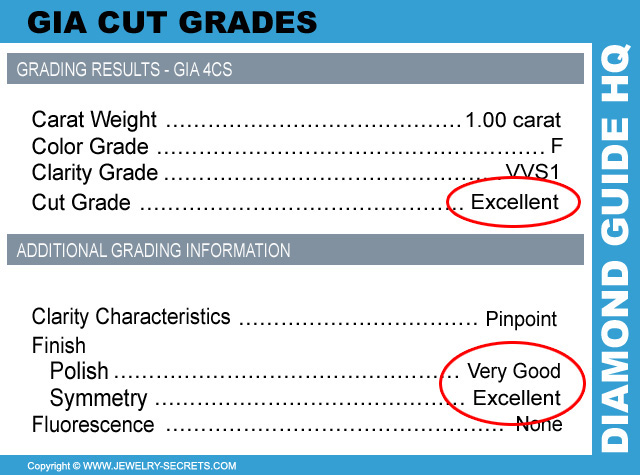
I usually advise sticking with Excellent or Very Good Cut Grades.
The actual Table Percentage will be listed on the Report at the bottom, called the Diamond Profile as seen here…
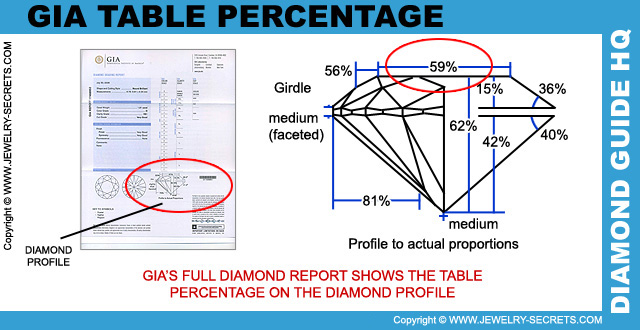
That’s the simplest and easiest way to know if your Diamond Table is Ideal, Good or Bad… as well as the rest of the Make of the stone.
Check the Diamond Report. It’s as plain as day!
Keep it Clean!
Lastly, a dirty Table shows all… or actually nothing at all! :)
If you get soaps, lotions, hairsprays, or even fingerprints on your Diamond, it will block out light, make your Diamond look dark and dull, and make it sparkle less. Not cool!
Keep it clean (at least once a week – Buy an Ultrasonic Cleaner if you need to), and it will make your Diamond sparkle like the day you bought it.
And… DO THIS!!!
When you put your rings on your fingers in the morning (or after a cleaning), don’t, I repeat, DON’T put your fingers on the top of your stone! You’ll instantly put oily fingerprints all over them which then collects dirt and dust.
Don’t touch the Table. Touch the sides of the ring instead.
Believe me, your Diamonds will thank you!
Had enough of Table?
Good, because I’m done! :)


















Leave a comment